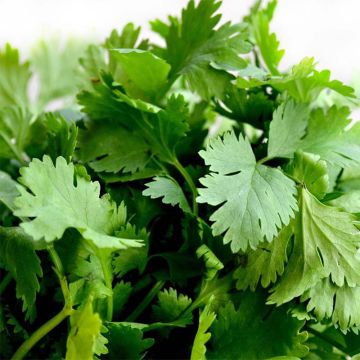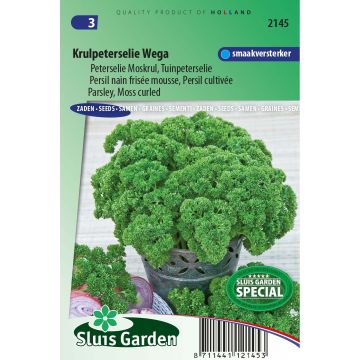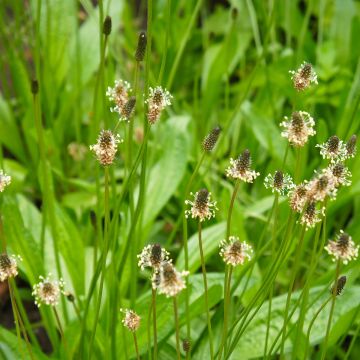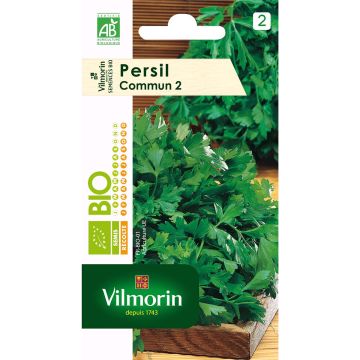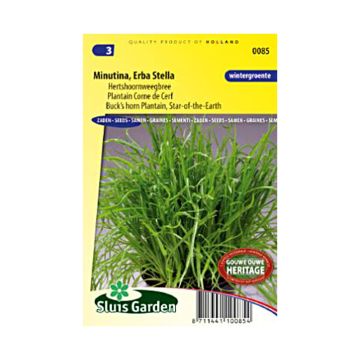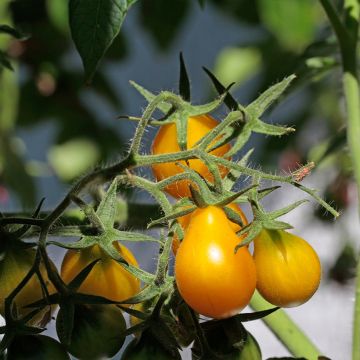

Garlic Chives - Ferme de Ste Marthe Seeds
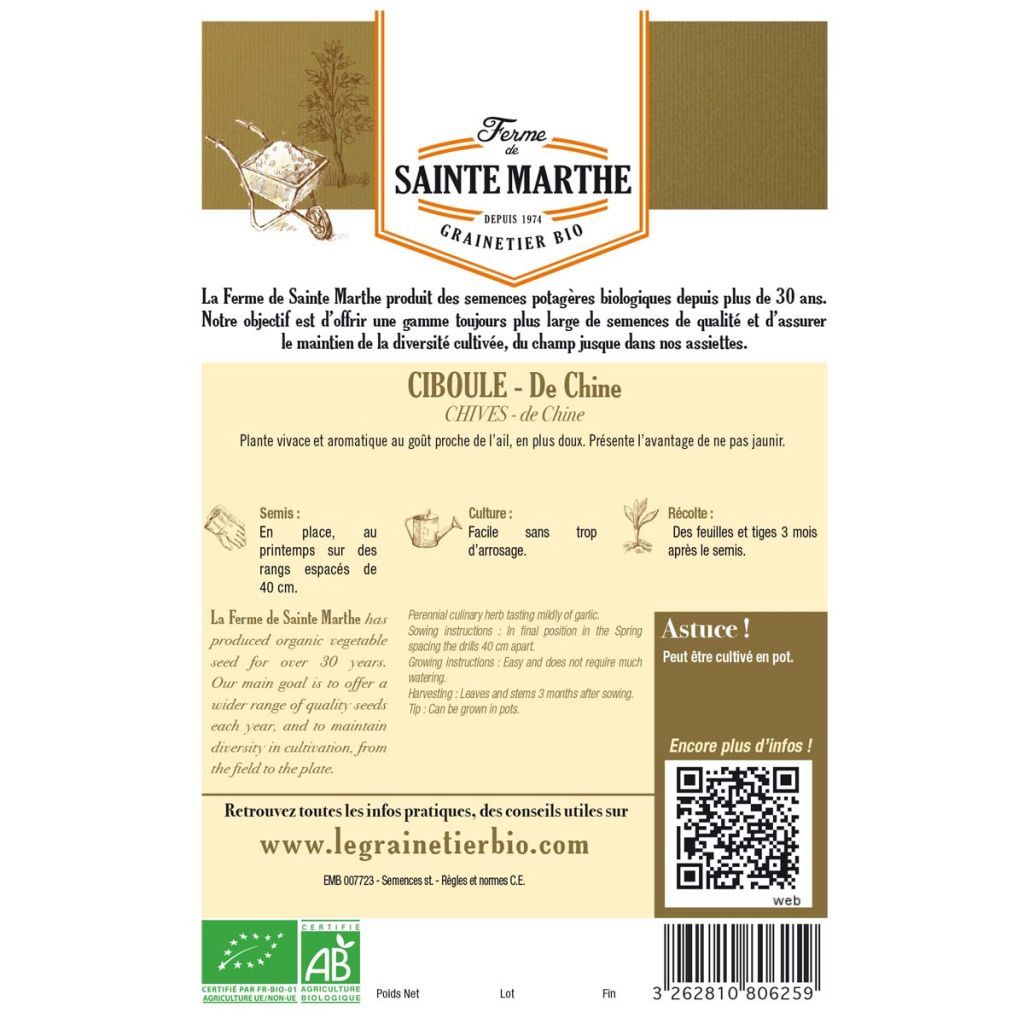

Garlic Chives - Ferme de Ste Marthe Seeds
Garlic Chives - Ferme de Ste Marthe Seeds
Allium tuberosum odorum chinensis
Chinese chives
Received. I just have to sow them now.
DEHAUD D., 26/03/2017
Special offer!
Receive a €20 voucher for any order over €90 (excluding delivery costs, credit notes, and plastic-free options)!
1- Add your favorite plants to your cart.
2- Once you have reached €90, confirm your order (you can even choose the delivery date!).
3- As soon as your order is shipped, you will receive an email containing your voucher code, valid for 3 months (90 days).
Your voucher is unique and can only be used once, for any order with a minimum value of €20, excluding delivery costs.
Can be combined with other current offers, non-divisible and non-refundable.
Why not try an alternative variety in stock?
View all →This plant carries a 6 months recovery warranty
More information
We guarantee the quality of our plants for a full growing cycle, and will replace at our expense any plant that fails to recover under normal climatic and planting conditions.
Description
Garlic chives, also known as Chinese chives, are related to common chives and spring onions. They are grown for their flat, grass-like leaves and edible white starry blooms. Their delicious garlicky flavour is perfect to enhance salads, omelettes and Asian cuisine! Sow from February to May and harvest from late May to September.
Garlic chives are a tasty perennial vegetable. They belong to the Allium family, along with garlic, onion, shallot and chives. They form 70 cm tall clumps of flat, grass-like leaves. They are generally grown for two to three years, after which they become less productive and need to be divided. Garlic chives produce attractive, edible white flowers. Both leaves and flowers are delicious served with omelettes, quiches and fish dishes. They are commonly used in Asian cuisine.
Harvesting: garlic chives can be harvested over a long period of time, from late spring to autumn. Simply snip off the leaves and flowers with scissors as and when required.
Conservation: garlic chives can be kept for a few days in the refrigerator or for a few months when dried or frozen. Nevertheless, for a fuller aroma they are definitely best eaten fresh!
Good to know: We recommend mulching as this reduces the need to water and weed your plants.
Even if the vegetable garden is first and foremost a place for growing great quality veg, it’s always a good idea to leave a bit of room for flowers. Growing flowers alongside your vegetable plants will make your general gardening experience more enjoyable and is a great way to attract pollinators and repel garden pests! Flowers such as gaillardia, marigolds, zinnias, cosmos or nasturtiums can be sown in and around the rows of vegetables. Herbs such as dill can be very useful also. Bear in mind that some companion plants self-seed easily and can be a bit invasive (borage, chives, lemon balm etc.)
NB. Organic seeds (in French "AB" for "Agriculture Biologique") are produced from plants that aren't treated with phytosanitary products (insecticides, weed killers). The seeds do not undergo post-harvest treatment. They carry the AB label and are approved by Ecocert, an independent structure.
Report an error about the product description
Harvest
Plant habit
Foliage
Botanical data
Allium
tuberosum odorum chinensis
Alliaceae
Chinese chives
Cultivar or hybrid
Perennial
Other Herb seeds
View all →Planting and care
Sowing:
The germination of Ciboule occurs at a temperature of about 15°C. It takes about 18 days for the seeds to sprout.
Sow the seeds from early September to November, either in a greenhouse or in an open field nursery:
In a cool place at home or under a greenhouse, in a tray with drainage holes and filled with a special seed compost, sow the seeds at a depth of 1 cm, spacing them 5 to 7 cm apart. Water with a very fine mist. Once your young plants have reached the size of a pen, you can plant them in the garden, just like leeks.
Sowing in an open field nursery is done later, when the soil is well warmed up, usually around mid-May, and is done in the same way as sowing in a greenhouse.
When planting permanently, maintain a distance of 30 to 40 cm between each row and 15 cm between each plant in the row.
Growing Ciboule:
Ciboule thrives in moderately rich soil and in full sun. If compost is needed, it is best to apply it in autumn, in the form of well-rotted compost, by scratching it into the soil to a depth of 5 cm, after loosening the soil as you would for any vegetable crop. This plant is quite tolerant of soil pH, and will do well if it is between 5.5 and 7.5. Ciboule produces beautiful white flowers, but it is recommended to cut the stems before they flower to preserve the aroma of the foliage.
Seedlings
Care
Intended location
-
, onOrder confirmed
Reply from on Promesse de fleurs
Similar products
Haven't found what you were looking for?
Hardiness is the lowest winter temperature a plant can endure without suffering serious damage or even dying. However, hardiness is affected by location (a sheltered area, such as a patio), protection (winter cover) and soil type (hardiness is improved by well-drained soil).

Photo Sharing Terms & Conditions
In order to encourage gardeners to interact and share their experiences, Promesse de fleurs offers various media enabling content to be uploaded onto its Site - in particular via the ‘Photo sharing’ module.
The User agrees to refrain from:
- Posting any content that is illegal, prejudicial, insulting, racist, inciteful to hatred, revisionist, contrary to public decency, that infringes on privacy or on the privacy rights of third parties, in particular the publicity rights of persons and goods, intellectual property rights, or the right to privacy.
- Submitting content on behalf of a third party;
- Impersonate the identity of a third party and/or publish any personal information about a third party;
In general, the User undertakes to refrain from any unethical behaviour.
All Content (in particular text, comments, files, images, photos, videos, creative works, etc.), which may be subject to property or intellectual property rights, image or other private rights, shall remain the property of the User, subject to the limited rights granted by the terms of the licence granted by Promesse de fleurs as stated below. Users are at liberty to publish or not to publish such Content on the Site, notably via the ‘Photo Sharing’ facility, and accept that this Content shall be made public and freely accessible, notably on the Internet.
Users further acknowledge, undertake to have ,and guarantee that they hold all necessary rights and permissions to publish such material on the Site, in particular with regard to the legislation in force pertaining to any privacy, property, intellectual property, image, or contractual rights, or rights of any other nature. By publishing such Content on the Site, Users acknowledge accepting full liability as publishers of the Content within the meaning of the law, and grant Promesse de fleurs, free of charge, an inclusive, worldwide licence for the said Content for the entire duration of its publication, including all reproduction, representation, up/downloading, displaying, performing, transmission, and storage rights.
Users also grant permission for their name to be linked to the Content and accept that this link may not always be made available.
By engaging in posting material, Users consent to their Content becoming automatically accessible on the Internet, in particular on other sites and/or blogs and/or web pages of the Promesse de fleurs site, including in particular social pages and the Promesse de fleurs catalogue.
Users may secure the removal of entrusted content free of charge by issuing a simple request via our contact form.
The flowering period indicated on our website applies to countries and regions located in USDA zone 8 (France, the United Kingdom, Ireland, the Netherlands, etc.)
It will vary according to where you live:
- In zones 9 to 10 (Italy, Spain, Greece, etc.), flowering will occur about 2 to 4 weeks earlier.
- In zones 6 to 7 (Germany, Poland, Slovenia, and lower mountainous regions), flowering will be delayed by 2 to 3 weeks.
- In zone 5 (Central Europe, Scandinavia), blooming will be delayed by 3 to 5 weeks.
In temperate climates, pruning of spring-flowering shrubs (forsythia, spireas, etc.) should be done just after flowering.
Pruning of summer-flowering shrubs (Indian Lilac, Perovskia, etc.) can be done in winter or spring.
In cold regions as well as with frost-sensitive plants, avoid pruning too early when severe frosts may still occur.
The planting period indicated on our website applies to countries and regions located in USDA zone 8 (France, United Kingdom, Ireland, Netherlands).
It will vary according to where you live:
- In Mediterranean zones (Marseille, Madrid, Milan, etc.), autumn and winter are the best planting periods.
- In continental zones (Strasbourg, Munich, Vienna, etc.), delay planting by 2 to 3 weeks in spring and bring it forward by 2 to 4 weeks in autumn.
- In mountainous regions (the Alps, Pyrenees, Carpathians, etc.), it is best to plant in late spring (May-June) or late summer (August-September).
The harvesting period indicated on our website applies to countries and regions in USDA zone 8 (France, England, Ireland, the Netherlands).
In colder areas (Scandinavia, Poland, Austria...) fruit and vegetable harvests are likely to be delayed by 3-4 weeks.
In warmer areas (Italy, Spain, Greece, etc.), harvesting will probably take place earlier, depending on weather conditions.
The sowing periods indicated on our website apply to countries and regions within USDA Zone 8 (France, UK, Ireland, Netherlands).
In colder areas (Scandinavia, Poland, Austria...), delay any outdoor sowing by 3-4 weeks, or sow under glass.
In warmer climes (Italy, Spain, Greece, etc.), bring outdoor sowing forward by a few weeks.


































